Budapest: Perbedaan antara revisi
Tidak ada ringkasan suntingan |
Tidak ada ringkasan suntingan |
||
| Baris 129: | Baris 129: | ||
Lebih dari 40 akademi dan universitas terletak di Budapest, termasuk [[Universitas Eötvös Loránd]], [[Universitas Semmelweis]], dan [[Universitas Teknologi dan Ekonomi Budapest]]. Kota ini juga memiliki jaringan kereta bawah tanah [[Metro Budapest]] yang dibuka pada tahun 1896<ref>Electric Railway Society (2003). https://books.google.com/books?id=9DdeAAAAIAAJ&redir_esc=y. Doppler Press. hlm. 61. Diakses 29 Agustus 2012.</ref> dan melayani 1,27 juta orang, sementara [[Tram di Budapest|Jaringan Tram Budapest]] melayani 1,08 juta penumpang setiap harinya.<ref name="BKV-report">{{cite web |author=Mátyás Jangel |url=http://ko.sze.hu/downloadmanager/download/nohtml/1/id/3174/m/3247 |title=Közszolgáltatási szerződés, utasjogok, a szolgáltatástervezés és ellenőrzés folyamata a kötöttpályás helyi- és elővárosi közforgalmú közlekedésben |publisher=BKV Zrt. Közlekedési Igazgatóság [Directorate of Public Office. Transport] |language=Hungarian |trans-title=Public service contract, passenger rights, service planning and monitoring process of local and suburban public transport rail |format=pdf |pages=10 (and 3) |date=September 2010 |accessdate=2015-04-19 |deadurl=yes |archiveurl=https://web.archive.org/web/20150128112007/http://ko.sze.hu/downloadmanager/download/nohtml/1/id/3174/m/3247 |archivedate=28 January 2015 |df=dmy-all }} Metro usage per day – Line 1: 120,000; Line 2: 405,000; Line 3: 630,000. (Line 4 began operations in 2014, with a 110,000 ridership estimated by Centre for Budapest Transport (BKK) based on the latest year.)</ref> Budapest sendiri masuk ke dalam peringkat kota yang paling dapat ditinggali di Eropa Tengah dan Timur menurut indeks [[kualitas hidup]] ''[[Economist Intelligence Unit]]''.<ref>{{cite web|url=https://index.hu/kulfold/2009/06/08/budapest_a_legelhetobb_kelet-europai_nagyvaros/ |title=Budapest is the most liveable Eastern European city |publisher=Index.hu |date=8 June 2009 |accessdate=27 May 2018}}</ref><ref name="hvg-20100211">{{cite web|url=http://hvg.hu/gazdasag/20100211_eiu_legelhetobb_varosok_listaja_2010_vanc |title=Gazdaság: EIU: Budapest, London és New York között a legjobban élhető városok listáján (Budapest between London and New York on the most liveable cities list)|publisher=HVG.hu |date=11 February 2010 |accessdate=26 May 2018}}</ref><ref>{{cite web|url=https://www.towerbudapest.com/en/property_management/news/budapest-is-the-50th-most-liveable-city-in-the-world/213|title=Budapest is the 50th Most Liveable City in the World|publisher= Tower International|accessdate=May 24, 2017}}</ref> |
Lebih dari 40 akademi dan universitas terletak di Budapest, termasuk [[Universitas Eötvös Loránd]], [[Universitas Semmelweis]], dan [[Universitas Teknologi dan Ekonomi Budapest]]. Kota ini juga memiliki jaringan kereta bawah tanah [[Metro Budapest]] yang dibuka pada tahun 1896<ref>Electric Railway Society (2003). https://books.google.com/books?id=9DdeAAAAIAAJ&redir_esc=y. Doppler Press. hlm. 61. Diakses 29 Agustus 2012.</ref> dan melayani 1,27 juta orang, sementara [[Tram di Budapest|Jaringan Tram Budapest]] melayani 1,08 juta penumpang setiap harinya.<ref name="BKV-report">{{cite web |author=Mátyás Jangel |url=http://ko.sze.hu/downloadmanager/download/nohtml/1/id/3174/m/3247 |title=Közszolgáltatási szerződés, utasjogok, a szolgáltatástervezés és ellenőrzés folyamata a kötöttpályás helyi- és elővárosi közforgalmú közlekedésben |publisher=BKV Zrt. Közlekedési Igazgatóság [Directorate of Public Office. Transport] |language=Hungarian |trans-title=Public service contract, passenger rights, service planning and monitoring process of local and suburban public transport rail |format=pdf |pages=10 (and 3) |date=September 2010 |accessdate=2015-04-19 |deadurl=yes |archiveurl=https://web.archive.org/web/20150128112007/http://ko.sze.hu/downloadmanager/download/nohtml/1/id/3174/m/3247 |archivedate=28 January 2015 |df=dmy-all }} Metro usage per day – Line 1: 120,000; Line 2: 405,000; Line 3: 630,000. (Line 4 began operations in 2014, with a 110,000 ridership estimated by Centre for Budapest Transport (BKK) based on the latest year.)</ref> Budapest sendiri masuk ke dalam peringkat kota yang paling dapat ditinggali di Eropa Tengah dan Timur menurut indeks [[kualitas hidup]] ''[[Economist Intelligence Unit]]''.<ref>{{cite web|url=https://index.hu/kulfold/2009/06/08/budapest_a_legelhetobb_kelet-europai_nagyvaros/ |title=Budapest is the most liveable Eastern European city |publisher=Index.hu |date=8 June 2009 |accessdate=27 May 2018}}</ref><ref name="hvg-20100211">{{cite web|url=http://hvg.hu/gazdasag/20100211_eiu_legelhetobb_varosok_listaja_2010_vanc |title=Gazdaság: EIU: Budapest, London és New York között a legjobban élhető városok listáján (Budapest between London and New York on the most liveable cities list)|publisher=HVG.hu |date=11 February 2010 |accessdate=26 May 2018}}</ref><ref>{{cite web|url=https://www.towerbudapest.com/en/property_management/news/budapest-is-the-50th-most-liveable-city-in-the-world/213|title=Budapest is the 50th Most Liveable City in the World|publisher= Tower International|accessdate=May 24, 2017}}</ref> |
||
Sejarah Budapest dimulai oleh kota [[Aquincum]] yang awalnya merupakan permukiman [[Kelt]]<ref name=Aqua/><ref>{{cite book |last=Sugar |first=Peter F. |author2=Péter Hanák|author3=[[Tibor Frank]] |title=A History of Hungary |url=https://books.google.com/?id=SKwmGQCT0MAC&printsec=frontcover |accessdate=19 May 2008 |year=1990 |publisher=[[Indiana University Press]] |isbn=0-253-20867-X |page=3 |chapter=Hungary before the Hungarian Conquest}}</ref> dan kemudian menjadi ibu kota provinsi [[Romawi]] yang disebut [[Pannonia Inferior]].<ref name=Aqua>{{cite encyclopedia |encyclopedia=Encyclopædia Britannica |title=Aquincum |url=https://www.britannica.com/place/Aquincum |year=2008 |publisher=Encyclopædia Britannica |accessdate=2016-03-16}}</ref> [[Bangsa Hongaria]] tiba di wilayah Budapest pada abad ke-9.<ref name=Travel>{{cite web |title=Budapest |publisher=Travel Channel |url=http://guides.travelchannel.com/budapest/city-guides/historical-background |accessdate=22 May 2008 |deadurl=yes |archiveurl=https://web.archive.org/web/20081009042714/http://guides.travelchannel.com/budapest/city-guides/historical-background |archivedate=9 October 2008 |df=dmy-all }}</ref> Permukiman pertama mereka dijarah oleh [[invasi Mongol ke Eropa|bangsa Mongol ]] pada tahun 1241.<ref name=Eleventh>{{Cite EB1911|wstitle=Budapest |volume=4 |pages=734–737}}</ref> Kota yang telah didirikan kembali lalu menjadi pusat budaya [[humanisme Renaisans]] pada abad ke-15.<ref>{{cite encyclopedia |last=Drake |first=Miriam A. |encyclopedia=Encyclopedia of Library and Information Science |title=Eastern Europe, England and Spain|url=https://books.google.com/?id=w1Xtjiyh9XYC&pg=PA2494#PPA2498,M1 |accessdate=22 May 2008 |year=2003 |publisher=CRC Press |id= |isbn=0-8247-2080-6 |pages=2498}}</ref><ref>{{cite book |last=Casmir |first=Fred L. |title=Communication in Eastern Europe: The Role of History, Culture, and media in contemporary conflicts |url=https://books.google.com/?id=be2UW6NyposC&pg=PA115 |accessdate=21 May 2008 |year=1995 |publisher=Lawrence Erlbaum Associates |isbn=0-8058-1625-9 |page=122 |chapter=Hungarian culture in communication}}</ref> Setelah kekalahan besar Hongaria dalam [[Pertempuran Mohács]] dan periode kekuasaan [[Kesultanan Utsmaniyah]] selama hampir 150 tahun,<ref>Molnar, A Concise History of Hungary, Chronology hlm. 15</ref> kawasan ini memulai lembaran baru sebagai kawasan yang sejahtera, dan Budapest menjadi [[kota global]] setelah disatukannya kota [[Buda]] dan [[Óbuda]] di tepi barat [[Sungai Donau]] dengan kota [[Pest, Hongaria|Pest]] di tepi timur pada tanggal 17 November 1873.<ref name=Encarta>{{cite encyclopedia |last=Török |first=András |encyclopedia=Encarta |title=Budapest |url=http://encarta.msn.com/encyclopedia_761572648/Budapest.html |accessdate=6 April 2008 |archiveurl=https://www.webcitation.org/5kwQS7I2L?url=http://encarta.msn.com/encyclopedia_761572648/Budapest.html |archivedate=31 October 2009 |deadurl=yes |df=dmy }}</ref><ref>Molnar, A Concise History of Hungary, Chronology hlm. 15.</ref> Budapest juga menjadi salah satu ibu kota [[Austria-Hongaria|Kekaisaran Austria-Hongaria]],<ref>Alexander Watson, ''Ring of Steel: Germany and Austria-Hungary at War, 1914–1918'' (2014).'' pp 536–40.: In the capital cities of Vienna and Budapest, the leftist and liberal movements and opposition parties strengthened and supported the separatism of ethnic minorities.</ref> sebuah [[kekuatan besar]] yang akhirnya bubar pada tahun 1918 akibat kekalahannya dalam [[Perang Dunia I]]. Kawasan kota ini pernah menjadi lokasi [[Revolusi Hongaria 1848]], [[Pertempuran Budapest]] pada tahun 1945, dan [[Revolusi Hongaria 1956]].<ref>UN General Assembly ''Special Committee on the Problem of Hungary'' (1957) {{cite web|url= http://mek.oszk.hu/01200/01274/01274.pdf |title=Chapter II.C, para 58 (p. 20) }} {{small|(1.47 MB)}}</ref><ref name=wilson>{{Cite book| title =Budapest 1900: A Historical Portrait of a City and Its Culture | author= John Lukacs | publisher= Grove Press|year= 1994|page=222 | isbn =978-0-8021-3250-5}}</ref> |
|||
Kota ini merupakan penggabungan yang dilakukan pada tahun [[1873]] terhadap dua kota bersebelahan, Obuda (sisi barat) dan Pest (sisi timur), namun terpisah oleh [[Sungai Donau]]. |
|||
Kota Budapest adalah sebuah [[Situs Warisan Dunia UNESCO|warisan dunia]] yang dilindungi oleh [[UNESCO]] mulai tahun 1987. |
Kota Budapest adalah sebuah [[Situs Warisan Dunia UNESCO|warisan dunia]] yang dilindungi oleh [[UNESCO]] mulai tahun 1987. |
||
== Catatan kaki == |
== Catatan kaki == |
||
Revisi per 16 Juli 2018 11.23
Budapest | |
|---|---|
| Ibu kota Hongaria Budapest főváros | |
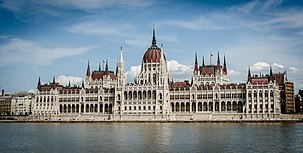 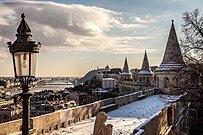 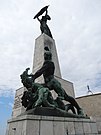 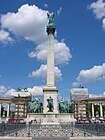  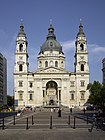 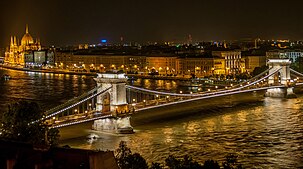 Dari atas, kiri ke kanan: Parlemen Hongaria, Halászbástya, Patung Kebebasan di Bukit Gellért, Alun-Alun Pahlawan di Taman Kota, Teater Nasional, Basilika Santo István dan Belváros dengan Jembatan Rantai Széchenyi pada malam hari | |
| Julukan: Jantung Eropa, Ratu Donau, Mutiara Donau, Ibu Kota Kebebasan, Ibu Kota Spa dan Pemandian Air Panas, Ibu Kota Festival | |
| Koordinat: 47°29′33″N 19°03′05″E / 47.49250°N 19.05139°E | |
| Negara | |
| Region | Hongaria Tengah |
| Penyatuan Buda, Pest dan Óbuda | 17 November 1873 |
| Jumlah satuan pemerintahan | 23 distrik
|
| Pemerintahan | |
| • Jenis | Wali Kota - Dewan |
| • Badan | Majelis Umum Budapest |
| • Wali Kota | István Tarlós (independen, didukung oleh Fidesz) |
| Luas | |
| • Kota | 525,2 km2 (202,8 sq mi) |
| • Luas perkotaan | 2.538 km2 (980 sq mi) |
| • Luas metropolitan | 7.626 km2 (2,944 sq mi) |
| Ketinggian | Paling rendah (Donau) 96 m Paling tinggi (Bukit János) 527 m m (315 hingga 1,729 ft) |
| Populasi | |
| • Kota | 1,779,361[1] |
| • Peringkat | Pertama (ke-10 di Uni Eropa) |
| • Kepadatan | 3.351/km2 (8,680/sq mi) |
| • Perkotaan | 2,947,722[4] |
| • Metropolitan | 3,303,786 |
| Demonim | Budapester, budapesti (bahasa Hongaria) |
| GDP/GVA PPP (2016) | |
| • Jumlah | $113,1 miliar / €103,8 miliar[8][9] |
| • Per kapita | $64.283 / €58.975[10] |
| PDB PPP (Metro) (2016) | |
| • Jumlah | $141 miliar / €129,4 miliar |
| • Per kapita | $42.678 / €39.169 |
| Zona waktu | UTC+1 (CET) |
| • Musim panas (DST) | UTC+2 (CEST) |
| Kode pos | 1011–1239 |
| Kode area telepon | 1 |
| Kode ISO 3166 | HU-BU |
| Kode NUTS | HU101 |
| Situs web | BudapestInfo Official Government Official |
| Nama resmi | Budapest, termasuk Tepi Sungai Donau, Kastil Buda dan Jalan Andrássy |
| Kriteria | Budaya: ii, iv |
| Nomor identifikasi | 400 |
| Pengukuhan | 1987 (Sesi ke-11) |
| Perluasan | 2002 |
| Luas | 473.3 ha |
| Zona pembatas | 493.8 ha |
Budapest (bahasa Hungaria: [ˈbudɒpɛʃt] (![]() simak))) adalah ibu kota dan kota terbesar di Hongaria, serta merupakan kota terbesar kesepuluh di Uni Eropa berdasarkan jumlah penduduk di batas kota.[11][12][13] Kota ini diperkirakan memiliki jumlah penduduk sebesar 1.752.704 jiwa pada tahun 2016 dan mereka tersebar di wilayah seluas 525 km2.[14][15] Secara administratif, Budapest merupakan sebuah kota dan kabupaten dan merupakan pusat wilayah metropolitan Budapest, yang memiliki luas sebesar 7.626 km2 dan jumlah penduduk sebesar 3.303.786, atau sekitar 33% jumlah penduduk Hongaria.[16][17] Wilayah metropolitan Budapest memiliki produk domestik bruto (PDB) sebesar $141,0 miliar (€129,4 miliar) pada tahun 2016 atau sekitar 49,6% PDB Hongaria.[18][9] PDB per kapita kota ini mencapai $64.283 atau sekitar 148% rata-rata PDB per kapita Uni Eropa berdasarkan keseimbangan kemampuan berbelanja.[10] Maka dari itu, kota ini masuk ke dalam 100 besar kota-kota di dunia berdasarkan pertumbuhan PDB tertinggi pada tahun 2008.[19]
simak))) adalah ibu kota dan kota terbesar di Hongaria, serta merupakan kota terbesar kesepuluh di Uni Eropa berdasarkan jumlah penduduk di batas kota.[11][12][13] Kota ini diperkirakan memiliki jumlah penduduk sebesar 1.752.704 jiwa pada tahun 2016 dan mereka tersebar di wilayah seluas 525 km2.[14][15] Secara administratif, Budapest merupakan sebuah kota dan kabupaten dan merupakan pusat wilayah metropolitan Budapest, yang memiliki luas sebesar 7.626 km2 dan jumlah penduduk sebesar 3.303.786, atau sekitar 33% jumlah penduduk Hongaria.[16][17] Wilayah metropolitan Budapest memiliki produk domestik bruto (PDB) sebesar $141,0 miliar (€129,4 miliar) pada tahun 2016 atau sekitar 49,6% PDB Hongaria.[18][9] PDB per kapita kota ini mencapai $64.283 atau sekitar 148% rata-rata PDB per kapita Uni Eropa berdasarkan keseimbangan kemampuan berbelanja.[10] Maka dari itu, kota ini masuk ke dalam 100 besar kota-kota di dunia berdasarkan pertumbuhan PDB tertinggi pada tahun 2008.[19]
Budapest merupakan kota global dengan keunggulan dalam bidang perdagangan, keuangan, media, seni, mode, penelitian, teknologi, pendidikan, dan hiburan.[20][21] Kota ini merupakan pusat keuangan dan R&D[22] dan mencapai peringkat tertinggi dalam Indeks Kota-Kota Inovatif di Eropa Tengah dan Timur.[23][24][25] Kota ini juga memiliki ekonomi kota dengan pertumbuhan tercepat kedua di Eropa.[26] Di kota ini terdapat bursa efek terbesar kedua di Eropa Tengah dan Timur berdasarkan kapitalisasi pasar, yaitu Bursa Efek Budapest.[27] Kawasan bisnisnya menjadi markas bank dan perusahaan nasional dan internasional yang besar.[28][29][30] Di Budapest juga terdapat kantor regional organisasi internasional, seperti Perserikatan Bangsa-Bangsa,[31] Institut Inovasi dan Teknologi Eropa,[32] dan Akademi Kepolisian Eropa.[33]
Lebih dari 40 akademi dan universitas terletak di Budapest, termasuk Universitas Eötvös Loránd, Universitas Semmelweis, dan Universitas Teknologi dan Ekonomi Budapest. Kota ini juga memiliki jaringan kereta bawah tanah Metro Budapest yang dibuka pada tahun 1896[34] dan melayani 1,27 juta orang, sementara Jaringan Tram Budapest melayani 1,08 juta penumpang setiap harinya.[35] Budapest sendiri masuk ke dalam peringkat kota yang paling dapat ditinggali di Eropa Tengah dan Timur menurut indeks kualitas hidup Economist Intelligence Unit.[36][37][38]
Sejarah Budapest dimulai oleh kota Aquincum yang awalnya merupakan permukiman Kelt[39][40] dan kemudian menjadi ibu kota provinsi Romawi yang disebut Pannonia Inferior.[39] Bangsa Hongaria tiba di wilayah Budapest pada abad ke-9.[41] Permukiman pertama mereka dijarah oleh bangsa Mongol pada tahun 1241.[42] Kota yang telah didirikan kembali lalu menjadi pusat budaya humanisme Renaisans pada abad ke-15.[43][44] Setelah kekalahan besar Hongaria dalam Pertempuran Mohács dan periode kekuasaan Kesultanan Utsmaniyah selama hampir 150 tahun,[45] kawasan ini memulai lembaran baru sebagai kawasan yang sejahtera, dan Budapest menjadi kota global setelah disatukannya kota Buda dan Óbuda di tepi barat Sungai Donau dengan kota Pest di tepi timur pada tanggal 17 November 1873.[15][46] Budapest juga menjadi salah satu ibu kota Kekaisaran Austria-Hongaria,[47] sebuah kekuatan besar yang akhirnya bubar pada tahun 1918 akibat kekalahannya dalam Perang Dunia I. Kawasan kota ini pernah menjadi lokasi Revolusi Hongaria 1848, Pertempuran Budapest pada tahun 1945, dan Revolusi Hongaria 1956.[48][49]
Kota Budapest adalah sebuah warisan dunia yang dilindungi oleh UNESCO mulai tahun 1987.
Catatan kaki
- ^ "Population by type of settlement – annually". Hungarian Central Statistical Office. 12 April 2016. Diakses tanggal 12 April 2016.
- ^ "The Municipality of Budapest (official)". Municipality of Budapest. 11 September 2014. Diakses tanggal 11 September 2014.
- ^ "Budapest". 2014 Encyclopædia Britannica, Inc. 11 September 2014. Diakses tanggal 11 September 2014.
- ^ "Functional Urban Areas – Population on 1 January by age groups and sex". Eurostat. 1 April 2016. Diakses tanggal 12 April 2016.
- ^ "Best view in Budapest from the city's highest hilltop". stay.com – Budapest. 11 September 2014. Diarsipkan dari versi asli tanggal 23 June 2010. Diakses tanggal 11 September 2014.
- ^ "Gazetteer of Hungary, Hungarian Central Statistical Office, 2012" (PDF). Diakses tanggal 2 October 2013.
- ^ "Budapest City Review". Euromonitor International. December 2017. Diakses tanggal 8 May 2014.
- ^ "English: 39,8% of the country's GDP produced in Budapest. Hungary's GDP PPP in 2017 is $284.266 billion (IMF) x 39,8% = $113.1 billion". portfolio.hu / Hungarian Central Statistical Office. Diakses tanggal 17 June 2017.
- ^ a b Ed F. Nozeman; Arno J. Van der Vlist (2014). European Metropolitan Commercial Real Estate Markets. Springer. hlm. 169. ISBN 978-3-642-37852-2.
- ^ a b "English: 39,8% of the country's GDP produced in Budapest. Hungary's GDP PPP in 2017 is $284.266 billion (IMF) x 39,8% = $113.1 billion / Budapest pop. 2016 (1.759.407) = $64,283". portfolio.hu / Hungarian Central Statistical Office. Diakses tanggal 17 June 2017.
- ^ Bachmann, Helena (18 March 2002). "Beauty and the Feast". Time. Diakses tanggal 22 May 2008.
- ^ Taşan-Kok, Tuna (2004). Budapest, Istanbul and Warsaw: Institutional and spatial change. Eburon Uitgeverij. hlm. 41. ISBN 978-90-5972-041-1. Diakses tanggal 21 May 2013.
- ^ Meer, Dr Jan van der; Carvalho, Dr Luis; Berg, Professor Leo van den (28 May 2014). Cities as Engines of Sustainable Competitiveness: European Urban Policy in Practice. Ashgate Publishing, Ltd. ISBN 978-1-4724-2704-5.
- ^ Kesalahan pengutipan: Tag
<ref>tidak sah; tidak ditemukan teks untuk ref bernamaPopulation14 - ^ a b Török, András. "Budapest". Encarta. Diarsipkan dari versi asli tanggal 31 October 2009. Diakses tanggal 6 April 2008.
- ^ "About Budapest Transport Association". Diarsipkan dari versi asli tanggal 14 October 2008. Diakses tanggal 1 June 2016. "About Budapest Transport Association". Diarsipkan dari versi asli tanggal 14 October 2008. Diakses tanggal June 1, 2016.
- ^ "telep lista" (PDF). Diarsipkan dari versi asli (PDF) tanggal 25 November 2006. Diakses tanggal 1 June 2016. "telep lista" (PDF). Diarsipkan dari versi asli (PDF) tanggal 25 November 2006. Diakses tanggal June 1, 2016.
- ^ "English: 49,6% of the country's GDP produced in Budapest metropolitan area, in Central Hungary (Budapest and Pest county). Hungary's GDP PPP in 2017 is $284.266 billion (IMF) x 49,6% = $141.0 billion". portfolio.hu / Hungarian Central Statistical Office. Diakses tanggal 17 June 2017.
- ^ "ukmediacentre.pwc.com". PricewaterhouseCoopers. Diarsipkan dari versi asli tanggal 31 May 2013. Diakses tanggal 12 May 2014.
- ^ "Hungary: Emerging Economic Power In Central And Eastern Europe". Thomas White International. Diakses tanggal 18 June 2017.
- ^ "Globalization and World Cities (GaWC) Research Network, Loughborough University". www.lboro.ac.uk. 24 April 2017. Diakses tanggal 24 May 2017.
- ^ "The Global Financial Centres Index 21" (PDF). Long Finance. March 2017.
- ^ "Innovation Cities Top 100 Index » Innovation Cities Index & Program – City data training events from 2THINKNOW for USA Canada America Europe Asia Mid-East Australia". Innovation-cities.com. 1 September 2010. Diakses tanggal 15 September 2011.
- ^ "CEE City Ranking puts capitals under the spotlight | Local and regional publications". Rolandberger.at. Diarsipkan dari versi asli tanggal 28 September 2011. Diakses tanggal 15 September 2011.
- ^ "Doing Business: Budapest, the soul of Central Europe". International Herald Tribune. 4 August 2004. Diarsipkan dari versi asli tanggal 3 November 2011. Diakses tanggal 29 January 2008.
- ^ "Budapest Europe's Second Fastest-Developing Urban Economy, Study Reveals – The study examines the development of the world's 300 largest urban economies, ranking them according to the pace of development". Brookings Institution. 23 January 2015. Diakses tanggal 8 March 2016.
- ^ "Originally established in 1864, today it is the second most liquid stock market in the Central and Eastern European region, with the total market capitalisation of listed firms standing at approximately US $33.8 billion".
- ^ "Regional Headquarters Central and Eastern Europe" (PDF). investinaustria.at. 23 September 2011. Diarsipkan dari versi asli (PDF) tanggal 21 September 2013. Diakses tanggal 12 May 2014.
- ^ "Magyarországon működő bankok - BankRáció.hu". www.bankracio.hu.
- ^ "Market Overview – BET shares capitalization: 7,170 billion HUF". Budapest Stock Exchange. Diakses tanggal May 24, 2017.
- ^ "International organizations in Hungary". Ministry of Foreign Affairs. Diarsipkan dari versi asli tanggal 13 March 2016. Diakses tanggal 20 November 2016.
- ^ "EU nations pick Budapest for technology institute". Sydney Morning Herald. 18 June 2008. Diakses tanggal 4 December 2014.
- ^ European Union Document Nos. 2013/0812 (COD), ENFOPOL 395 CODEC 2773 PARLNAT 307
- ^ Electric Railway Society (2003). https://books.google.com/books?id=9DdeAAAAIAAJ&redir_esc=y. Doppler Press. hlm. 61. Diakses 29 Agustus 2012.
- ^ Mátyás Jangel (September 2010). "Közszolgáltatási szerződés, utasjogok, a szolgáltatástervezés és ellenőrzés folyamata a kötöttpályás helyi- és elővárosi közforgalmú közlekedésben" [Public service contract, passenger rights, service planning and monitoring process of local and suburban public transport rail] (dalam bahasa Hungarian). BKV Zrt. Közlekedési Igazgatóság [Directorate of Public Office. Transport]. hlm. 10 (and 3). Diarsipkan dari versi asli (pdf) tanggal 28 January 2015. Diakses tanggal 19 April 2015. Metro usage per day – Line 1: 120,000; Line 2: 405,000; Line 3: 630,000. (Line 4 began operations in 2014, with a 110,000 ridership estimated by Centre for Budapest Transport (BKK) based on the latest year.)
- ^ "Budapest is the most liveable Eastern European city". Index.hu. 8 June 2009. Diakses tanggal 27 May 2018.
- ^ "Gazdaság: EIU: Budapest, London és New York között a legjobban élhető városok listáján (Budapest between London and New York on the most liveable cities list)". HVG.hu. 11 February 2010. Diakses tanggal 26 May 2018.
- ^ "Budapest is the 50th Most Liveable City in the World". Tower International. Diakses tanggal May 24, 2017.
- ^ a b "Aquincum". Encyclopædia Britannica. Encyclopædia Britannica. 2008. Diakses tanggal 2016-03-16.
- ^ Sugar, Peter F.; Péter Hanák; Tibor Frank (1990). "Hungary before the Hungarian Conquest". A History of Hungary. Indiana University Press. hlm. 3. ISBN 0-253-20867-X. Diakses tanggal 19 May 2008.
- ^ "Budapest". Travel Channel. Diarsipkan dari versi asli tanggal 9 October 2008. Diakses tanggal 22 May 2008.
- ^
 Chisholm, Hugh, ed. (1911). "Budapest". Encyclopædia Britannica. 4 (edisi ke-11). Cambridge University Press. hlm. 734–737.
Chisholm, Hugh, ed. (1911). "Budapest". Encyclopædia Britannica. 4 (edisi ke-11). Cambridge University Press. hlm. 734–737.
- ^ Drake, Miriam A. (2003). "Eastern Europe, England and Spain". Encyclopedia of Library and Information Science. CRC Press. hlm. 2498. ISBN 0-8247-2080-6. Diakses tanggal 22 May 2008.
- ^ Casmir, Fred L. (1995). "Hungarian culture in communication". Communication in Eastern Europe: The Role of History, Culture, and media in contemporary conflicts. Lawrence Erlbaum Associates. hlm. 122. ISBN 0-8058-1625-9. Diakses tanggal 21 May 2008.
- ^ Molnar, A Concise History of Hungary, Chronology hlm. 15
- ^ Molnar, A Concise History of Hungary, Chronology hlm. 15.
- ^ Alexander Watson, Ring of Steel: Germany and Austria-Hungary at War, 1914–1918 (2014). pp 536–40.: In the capital cities of Vienna and Budapest, the leftist and liberal movements and opposition parties strengthened and supported the separatism of ethnic minorities.
- ^ UN General Assembly Special Committee on the Problem of Hungary (1957) "Chapter II.C, para 58 (p. 20)" (PDF). (1.47 MB)
- ^ John Lukacs (1994). Budapest 1900: A Historical Portrait of a City and Its Culture. Grove Press. hlm. 222. ISBN 978-0-8021-3250-5.
Pranala luar
- (Inggris) Budapest information portal
- (Inggris) Hungary Tourism
- Info Budapest
- Information portal about Budapest
- (Inggris) Budapest and Hungary Travel Guide
- (Inggris) Worldguide by Lonely Planet
- (Inggris) Kota Budapest - situs warisan dunia
- (Inggris) Budapest.hu
- (Inggris) Budapest pages




